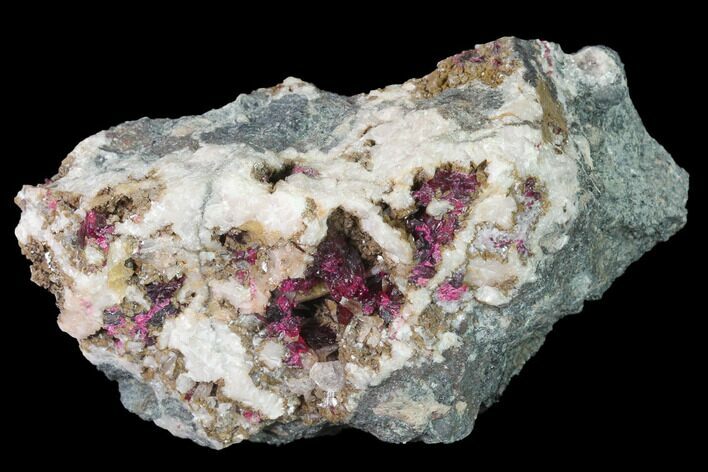This Specimen has been sold.
3.9" Roselite Crystal Clusters on Dolomite - Morocco
This is a cluster of very richly colored roselite crystals within a dolomite matrix, collected from the Bou Azer District of Morocco.
Roselite is an arsenate mineral in the monoclinic crystal system. It gained its name not from the rose color it generally exhibits, but was in fact named in honor of a German mineralogist by the name of Gustav Rose. However, the name is quite fitting, since roselite typically displays a vitreous rose-red to pink color. Darker crystals have been known to frequently display marked color zoning due to variations in molecular composition.
Roselite has the chemical formula Ca2Co(AsO4)2 · 2H2O, meaning it contains arsenic. While it doesn't pose an immediate health risk from purely handling, ingestion in significant amounts and/or crushing and inhaling roselite can be toxic. For this reason, we suggest washing hands after handling and keeping out of reach of children.
Roselite has the chemical formula Ca2Co(AsO4)2 · 2H2O, meaning it contains arsenic. While it doesn't pose an immediate health risk from purely handling, ingestion in significant amounts and/or crushing and inhaling roselite can be toxic. For this reason, we suggest washing hands after handling and keeping out of reach of children.
Dolomite is an anhydrous carbonate mineral composed of calcium magnesium carbonate (CaMg(CO3)2).
The mineral dolomite crystallizes in the trigonal-rhombohedral system. It forms white, tan, gray, or pink crystals. Dolomite is a double carbonate, having an alternating structural arrangement of calcium and magnesium ions. It does not rapidly dissolve in dilute hydrochloric acid as calcite does. Crystal twinning is common.
Dolomite was first described by Carl Linnaeus in 1768, and in 1791 it was described as a rock by the French naturalist and geologist Déodat Gratet de Dolomieu. He first recognized the material in buildings of the old city of Rome, and later as samples collected in the mountains known as the Dolomite Alps of northern Italy.
The mineral dolomite crystallizes in the trigonal-rhombohedral system. It forms white, tan, gray, or pink crystals. Dolomite is a double carbonate, having an alternating structural arrangement of calcium and magnesium ions. It does not rapidly dissolve in dilute hydrochloric acid as calcite does. Crystal twinning is common.
Dolomite was first described by Carl Linnaeus in 1768, and in 1791 it was described as a rock by the French naturalist and geologist Déodat Gratet de Dolomieu. He first recognized the material in buildings of the old city of Rome, and later as samples collected in the mountains known as the Dolomite Alps of northern Italy.
SPECIES
Roselite & Dolomite
LOCATION
Bou Azer District, Morocco
SIZE
3.9 x 2"
CATEGORY
ITEM
#141664
 Reviews
Reviews













